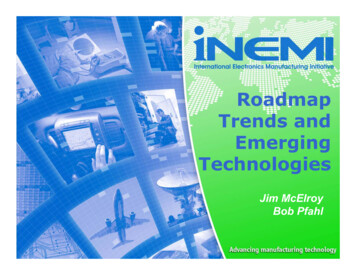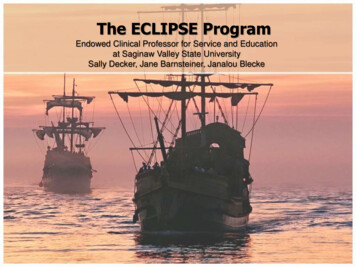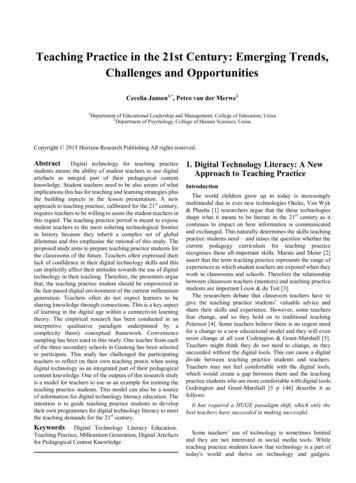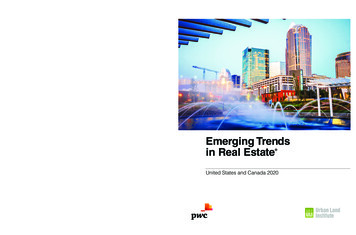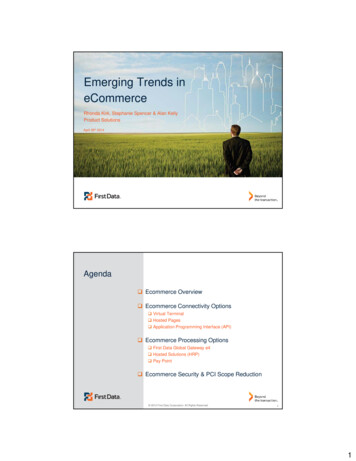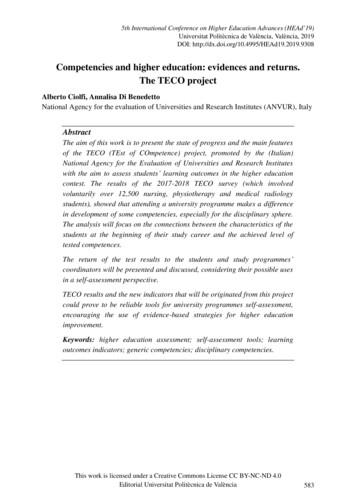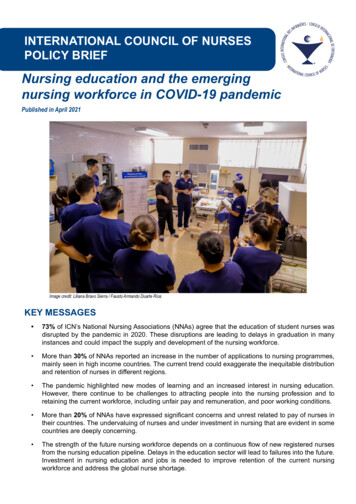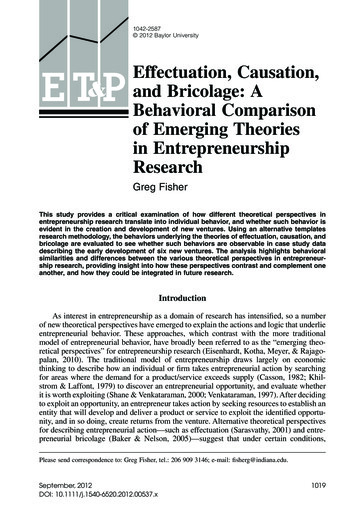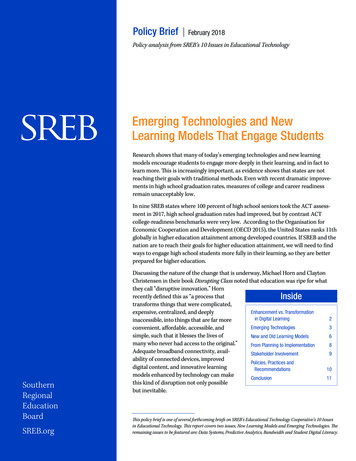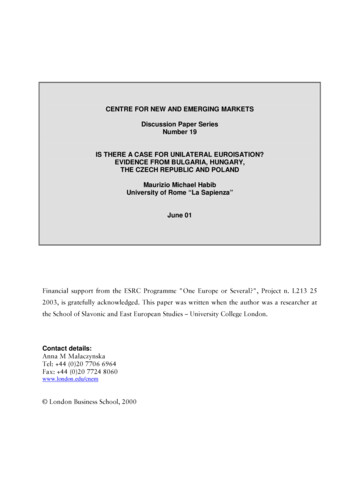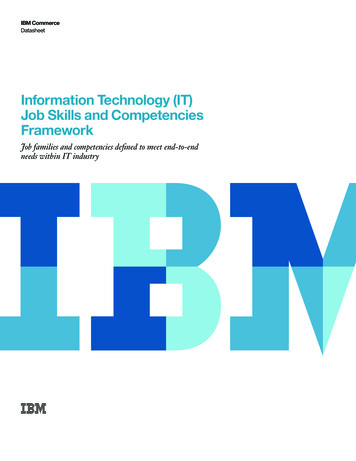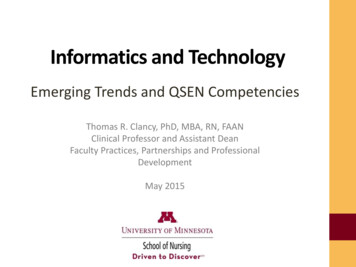
Transcription
Informatics and TechnologyEmerging Trends and QSEN CompetenciesThomas R. Clancy, PhD, MBA, RN, FAANClinical Professor and Assistant DeanFaculty Practices, Partnerships and ProfessionalDevelopmentMay 2015
DisclosureI have no relevant financial interest to disclose noram I endorsing any commercial productsidentified in this presentation.
Objectives Discuss emergingtrends in NursingInformatics and theirimpact on QSENcompetencies. Provide exemplars &resources forteaching esearch/index.php?catid 2
Inpatient Days per 1,000 Persons,1992 – 2012Inpatient Days per 9900010203040506070809101112Source: Avalere Health analysis of American Hospital Association Annual Survey data, 2012, for community hospitals. US Census Bureau: Nationaland State Population Estimates, July 1, 2012.Link: xpectancy-andchild-mortality-over-history-2014-1
Hospital Outpatient Visits per 1,000Persons, 1992 – 20122,500Visits per 304050607080910Source: Avalere Health analysis of American Hospital Association Annual Survey data, 2012, for community hospitals. US Census Bureau: Nationaland State Population Estimates, July 1, 2012.Link: 2/index.html.Previously Chart 3.13 in 2013 and earlier years’ Chartbooks.1112
Shift in the Hospital CentricModel of CareAlthough the totalnumber of nursesworking in hospitalshas increased, theproportion of the totalRN workforce in acutecare has declined from67% in 1993 to 61% in2014.Hospitals; state,local, and privateNursing andresidential carefacilitiesOffices ofphysicians61%7%7%Home health careservices6%Government6%Bureau of Labor Statistics, U.S. Department of Labor, Occupational Outlook Handbook, 2014-15 Edition, Registered Nurses,on the Internet at s.htm (visited April 18, 2015).
The Future of the Nursing Workforce: Nationaland State-Level Projections, 2012-2025While not considered in thisstudy, emerging caredelivery models, with afocus on managing healthstatus and preventingacute health issues, willlikely contribute to newgrowth in demand fornurses, e.g., nurses takingon new and/or expandedroles in preventive care andcare coordination.U.S. Department of Health and Human Services, Health Resources and Services Administration, National Center for HealthWorkforce Analysis. The Future of the Nursing Workforce: National- and State-Level Projections, 2012-2025. Rockville, Maryland,2014.
Hospitals Without WallsModern HealthcareNaval Hospital, CampPendletonWhile the “bedless hospital” mayexist only as a concept today,the idea of using bed counts tosize up hospitals could be readyfor retirement.One notable example of this isthe massive new 451 millionreplacement naval hospital beingbuilt at Camp Pendleton nearSan Diego. Scheduled to becompleted next January, the497,000-square-foot facilitywill house only 67 126/MAGAZINE/301269979
Technology Trends1. Exponential growthin computerprocessing speed,2. The digitization ofeverything,3. Build-out of theIntranet,4. Mobile technology,social media &increasedconnectivityMoores Law.Courtesy of Ray Kurzweil and Kurzweil Technologies, Inc. - en:Image:PPTMooresLawai.jpgAccessed from Wikipedia on Sept. 17, 2014 at:http://en.wikipedia.org/wiki/Accelerating change#mediaviewer/File:PPTMooresLawai.jpg
Sensor Data:Mobile Health & The Intranet of ThingsMedical and publichealth practicessupported by mobiledevices, such asmobile phones, patientmonitoring devices,personal digitalassistants (PDAs), andother wireless devices.http://www.youtube.com/watch?v /mHealthmHealth: New horizons for health through mobile technologies, World HealthOrganization, Global Observatory for eHealth series - Volume 3, 2011
Electronic Health Record Data:HITECH and Meaningfull UseProjections are for90 percent ofproviders to haveaccess to a fullyoperationalelectronic healthrecords by 2019, upfrom 34-35 percentin 2011.
Whole Gene Sequencing Data Process thatdetermines thecomplete DNAsequence of anorganism's genome ata single time. Data will be animportant tool toguide therapeuticintervention in thefuture.Mooney, Sean (Sep 2014). "Progress towards theintegration of pharmacogenomics in practice". HumanGenetics. doi:10.1007/s00439-014-1484-7. PMID 25238897There are six billion base pairs ineach human diploid genome
Social Media DataTop Five US Websites in 2015Website Facebook Twitter LinkedIn Pinterest Google 0,000120,000,0001,835,000,000
Geo-Spatial DataData which has ageographical orgeospatial aspectincluding the use ofgeographicinformation systemsand geometrics(GPS).The geospatial web – blending physicaland virtual spaces., Arno Scharl inreceiver magazine, Autumn 2008Hot ector/
Big Data: Healthcare CMS – Center forMedicare & Medicaid NIH -ClinicalTranslational ScienceAward PCORnet – Patientcentered outcomesresearch Commercial – OptumLabs ResearchCollaborative 2 billion data pointsper year 62 medical researchinstitutions in 32 states 11 Clinical researchnetworks & 18 patientpowered networks 150 million lives, 3200data points per life,over 20 years.
Human Graphic InformationSystem (GIS) Multiple layers ofdemographic,physiologic,anatomic, biologicand environmentaldata about aparticularindividual.Topel, E. (2015). The PatientWill See You Now. Basic Books,New 1536863233
Knowledge EngineeringData Mash-upsKnowledge Value
Knowledge Engineering Decision trees Association rules Artificial neuralnetworks Support vectormachines Clustering Bayesian networks Genetic algorithmsMachine Learning
Knowledge EngineeringKnowledgeengineering of big datawill dramaticallychange how healthcareproviders treat andcare for patientsthrough their ability todescribe, predict andprevent health events.Knowledge Engineering andPersonalized Medicine
Knowledge ValueEmbedded in TechnologyiPhone Proximity sensorAmbient light sensorAccelerometerMagnetometerGyroscopic sensorCamera/VideoVoice recognition (Siri)PhoneEmail/TextIntranetNLP
Augmented Cognition Apps:Algorithmic Symptom Checkers WebMD MobileiTriageHealthMedscape MobileDiagnosaurus DDxSymptoms TakToolsiHeadacheSignsSx HandbookSymptom MateDifferential Dx i-pocketSTATworkUPeRoentgen Radiology DXSymptom MinderPocket Symptom Analyzerhttps://www.youtube.com/watch?v CQqBMG578tAImage: http://www.thinklabs.com/#!thinklink/cbor
Prediction:Modified Early Warning System (MEWS)Scoring is based on: Respiratory rate Heart rate Systolic bloodpressure Conscious level Temperature Hourly urine output(for previous 2 aveLives.aspx
Prevention: Asthma AttacksSensor Cluster: Air quality Pollen Inhaler use Geo-location Breath nitric oxide Lung function –Smartphone app RR, Temp, O2 sat.Wearable and Implantable Wireless Sensor Network Solutions for Healthcare Monitoring. Ashraf Darwish and Aboul EllaHassanien : Accessed at Sensors website: http://www.mdpi.com/1424-8220/11/6/5561/htm
Prevention: Heart Failure EventsSensor Cluster Beat to beat variability Fluid status Sleep quality Apneic spells Vital signs Lab tests (via smartphone app) Med. adherence (viadigitized pills)https://www.youtube.com/watch?v -uTsMCvT7X8
https://www.youtube.com/watch?v ospital-room/
Todays Barriers Interoperability of electronic health record systems across thecontinuum Poor workflow design, usability, functionality andhuman/computer interface Lack of standardized nursing terminologies and missing datato share and compare interventions and clinical outcomes Lack of financial and human resources to implement EHR andother systems Capacity to process and store multiple data forms (structured,unstructured, audio, video, streaming, waveforms) Computer literacy among healthcare providers and nursingschool faculty
Why Informatics?Computer and information literacy are crucialto the future of nursing for advancing improvements in: Safety Evidence based practice Outcomes research Inter-professional care coordination Cost effectivenessGraduates of nursing programs must have competence inusing both patient care technologies and informationmanagement systems.McNeil, B. J., Elfrink, V. L., Bickford, C. J., Pierce, S. T., Beyea, S. C., Averil, C., & Klappenbach, C. (2003). “Nursing informationtechnology knowledge, skils, and preparation of student nurses, nursing faculty, and clinicians: A US survey.”Journal of Nursing Education 42 (8):3419.
Exponential Growth in ComplexityDecades of rapidinnovation andtechnologicalimprovement havecreated anextraordinarilycomplex healthcaresystem. So much sothat healthcare oftenfalls short of itspotential.Smith, M., Saunders, R., Stuckhardt, L., and McGinnis, M.(2012). Best Care at Lower Cost: The Path to ContinuouslyLearning Health Care in America. Institute of Medicine,National Academies Press.Typical chronicdisease pt. 79 years old, Osteoporosis, Osteoarthritis, Type 2 diabetes, Hypertension, COPD,
Exponential Growth inInteractionsTypical Patient See 7 doctors across4 practices 27 different healthproviders (surgerypatient) 19 medications perdaySmith, M., Saunders, R., Stuckhardt, L., and McGinnis, M. (2012).Best Care at Lower Cost: The Path to Continuously LearningHealth Care in America. Institute of Medicine,National Academies Press.
Exponential Growth in ActivitiesTypical Physician Interacts with 229other physicians in117 differentpractices.Typical ICU Nurse Manages 180activities per patientper day!Smith, M., Saunders, R., Stuckhardt, L., and McGinnis, M. (2012).Best Care at Lower Cost: The Path to Continuously LearningHealth Care in America. Institute of Medicine,National Academies Press.
Standards and GuidelinesAACN Essentials forInformation ManagementAnd Patient CareTechnologiesQuality, Safety &Education for NursesKnowledge, Skillsand AttitudesTechnologyInformatics GuidingEducation ReformCompetencies forPracticing Nurses
Competency Matrix for NursingInformaticsAACN tXXXMastersXXXXXDoctor ofNursingPracticeXXXXXAACNEssentialsDNPX
Pre-licensure QSENCompetencies: Knowledge Explain why information and technology skills are essential forsafe patient care. Identify essential information that must be available in acommon database to support patient care . Contrast benefits and limitations of differentcommunication technologies and their impact on safetyand quality Describe examples of how technology and informationmanagement are related to the quality and safety ofpatient care . Recognize the time, effort, and skill required forcomputers, databases and other technologies to becomereliable and effective tools for patient care
QSEN Pre-licensureCompetencies: Skills Seek education about how information is managed in caresettings before providing care. Apply technology and information management tools tosupport safe processes of care. Navigate the electronic health record. Document and plan patient care in an electronic healthrecord. Employ communication technologies to coordinate care forpatients. Respond appropriately to clinical decision-making supportsand alerts Use information management tools to monitor outcomes ofcare processes. Use high quality electronic sources of healthcare information.
Graduate QSEN GraduateCompetencies: Knowledge Utilize systems theory to plan, design, implement andevaluate the capacity of information systems and patientcare technologies to improve the quality and safety ofpatient care. Participate in the design of continuous learning systemsthat identify, capture, store and communicate keyelectronic data elements that represent the impact ofnurse sensitive performance measures. Support taxonomic and terminology systems used innational efforts to enhance interoperability of informationsystems and knowledge management systems.
Graduate QSEN GraduateCompetencies: Knowledge Participate in the planning, design, implementation andevaluation of information systems and technologies usedto engage and empower patients as partners inmanaging their own care Provide oversight regarding compliance with federal andother regulations related to the selection andimplementation of information systems and theircapacity to protect the safety, confidentiality and securityof patient data.
Emphasis on EHR & Meaningful UseTransformhealth careImprovedpopulation healthAccess toinformationEnhanced accessand continuityData utilized toimprove deliveryand outcomesData utilized toimprove deliveryand outcomesPatient selfmanagementPatient engaged,communityresourcesCare coordinationCare coordinationPatient centeredcare coordinationPatient informedEvidenced basedmedicineTeam based care,case managementBasic EHRfunctionality,structured dataStructured datautilizedRegistries fordiseasemanagementRegistries tomanage patientpopulationsPrivacy & securityprotectionsPrivacy & securityprotectionsPrivacy & securityprotectionsPrivacy & securityprotectionsStage 1 MUStage 2 MUPCMH3-Part AimACO’s“Stage 3 MU”Utilizetechnology
Knowledge Complexity rmationDataInformationSystemsCognitive LoadExpertSystems
Safety: Handwrit
Hospitals; state, local, and private 61% Nursing and residential care facilities 7% Offices of physicians 7% Home health care services 6% Government 6%. Bureau of Labor Statistics, U.S. Department of Labor, Occupational Outlook Handbook, 2014-15 Edition, Registered Nurses, on the Internet at s.
